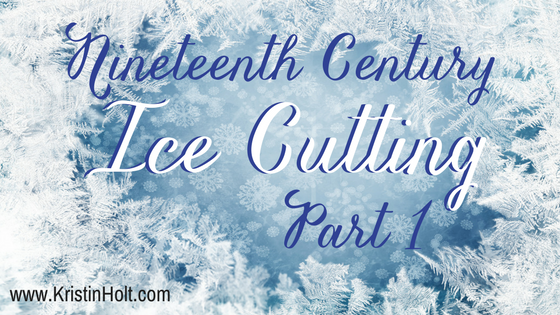
by Kristin Holt | Feb 6, 2018 | Articles
Rotary Egg Beaters are an American Victorian invention–and came along early enough to make a significant difference to home cooks…early enough for homemade Angel’s Food Cake! So why, then, do so many recipes insist upon beating the egg whites by hand–for a full hour? Why not use the newly patented, amazingly successful invention?

by Kristin Holt | Jan 25, 2017 | Articles
Nineteenth Century Ice Cutting, Part 2 (of 3): Staged as the adventures (and discoveries) of a boy in New England in the late 19th century, Lawrence’s Adventures, published in 1871 in Massachusetts, is instructive and entertaining. One of the chapters focuses wholly on the process of Ice-Cutting, and I share this now public domain content along with era-specific images showing the process. The information about how ice companies actually cut the ice from frozen lakes to provide Victorian America with the tons of ice demanded during the spring, summer, and autumn to sustain perishable food, chill beverages, transport perishable food via train, and aid the sick.

by Kristin Holt | Jan 22, 2017 | Articles
Nineteenth Century Ice Cutting, Part 1 (of 3): Ice cutting was a boom business in the mid 1800s. Tons of ice were harvested each winter in the Northeast portion of the United States, housed near rivers and railway spurs, and shipped near and far for use in the remaining seasons of the year. An image from August 1884 Harper’s Weekly, a patent from 1841, a spot of Victorian humor, and newspaper clippings shed light on the significant ice trade.

by Kristin Holt | Sep 5, 2016 | Articles
LABOR DAY was born of the circumstances within our Victorian-era United States Industrial Revolution. Unions wanted safer working conditions and 12- to 16-hour work days shortened to 8- or 9-hours. Strikes and protests lead to reform, and from the first Labor Day parade in 1882 peaceful Labor’s Holidays began to take root state by state until in 1894, Labor Day was declared by the President of the United States as a Federal Holiday. This article contains newspaper accounts from era papers, vintage photographs, and a dash of American history surrounding summer’s last hurrah.












